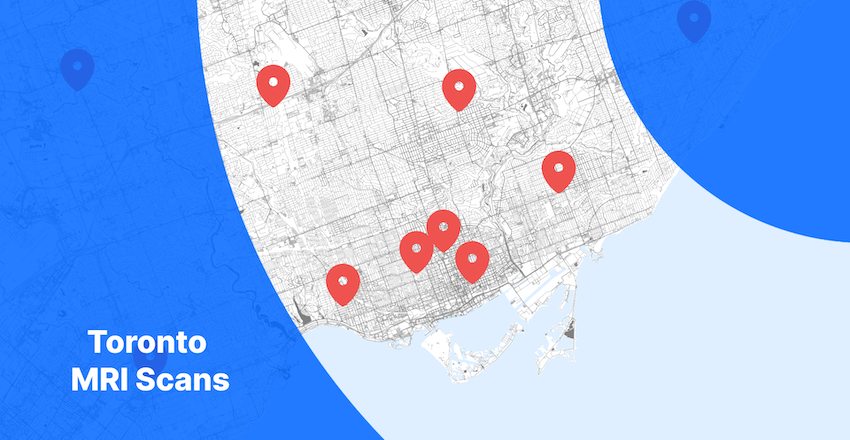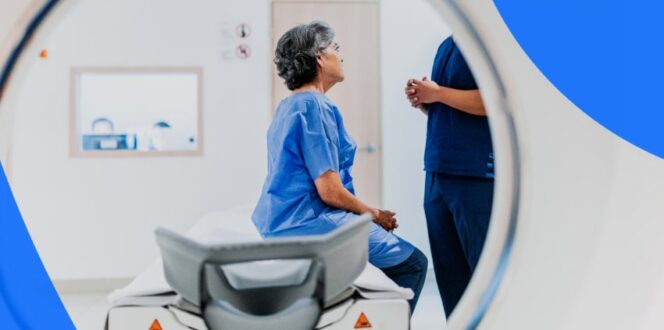Getting an MRI Scan in Toronto? What to Know Before You Go

Getting an MRI scan in Toronto? Here’s what to know before your appointment and how to access your results faster.
An MRI, or magnetic resonance imaging, is an imaging procedure used to detect or diagnose diseases, or to monitor progress following treatment. MRIs use very strong magnets and radio waves to create detailed 3D images of the inside of your body.
If your doctor sends you for an MRI, you may have some questions about the imaging procedure itself and any next steps. To help you prepare, this article breaks down:
- What to expect before getting an MRI
- Where to get one in Toronto
- What the wait times are for an appointment
- How to access and understand your imaging results
When should you get an MRI scan?
Doctors request MRIs to help detect, diagnose and measure the treatment of diseases and injuries. If you experience migraines, sudden hearing or vision loss, unusual dizziness, vertigo or seizures, or unexplained joint or soft tissue pain or swelling, you might be referred for an MRI.
Because of the detailed 3D anatomical scans they provide, MRIs are very helpful when diagnosing:
- Brain and spinal cord conditions, like aneurysms, injuries, Multiple Sclerosis (MS), pinched nerves, strokes and more
- Cardiovascular issues, such as circulatory blockages, congenital heart disease or heart attacks, infections or structural damage
- Cancer and tumors anywhere in the body
- Organ damage or disease
- Joint problems or decay caused by arthritis
- Soft tissue injuries, like meniscal tears or ACL injuries
There are several types of MRIs. Which type of scan you receive will depend on the symptoms you experience and the condition your doctor is attempting to diagnose:
- Functional MRI (fMRI) measures cortical activity by detecting minute changes in blood flow.
- MRA stands for magnetic resonance angiography and specifically examines blood vessels.
- MRV, or magnetic resonance venography, examines veins.
- A breast MRI takes detailed images of breast tissue. Unlike mammograms, they do not use radiation.
- A cardiac MRI examines the structures of the heart.
Depending on the kind of MRI you need, you may or may not have a contrast dye injected before your scan. This helps improve the clarity of the images so the radiologist can make a more accurate diagnosis.
What’s the difference between a CT scan and an MRI?
CT scans and MRIs both provide detailed images of the inside of the body to help doctors diagnose and treat illness and injury. CT scans use low-dose radiation X-rays to create the images, while MRIs use magnets and radio waves.
Softer parts of the body like ligaments, muscles and tendons show up more clearly on MRI scans. CT scans are better able to detect anomalies in bones and skeletal structures. CT scans also take less time, as little as 10 minutes for simple procedures, while an MRI can last an hour or more. This makes CT scans a more common and less expensive procedure than MRI scans.
Your doctor will decide which test is appropriate for you based on its effectiveness at providing diagnostic detail for your particular concern.
Where to get an MRI scan in Toronto
Typically, you won’t book an MRI scan yourself. Instead, your referring physician will send your requisition directly to the imaging department of a hospital who will contact you with the date and time of your appointment. MRI appointments are in high demand and have limited availability. They are not walk-in services.
Toronto hospitals that conduct MRI exams include:
- Etobicoke General
- The Hospital for Sick Children
- Humber River
- Michael Garron
- Mount Sinai
- North York General
- Princess Margaret
- Queensway Health Centre
- St. Joseph’s
- St. Michael’s
- Scarborough Health Network (Birchmount)
- Scarborough General
- Sunnybrook
- Toronto General
- Toronto Western
- Women’s College Hospital
In Toronto, you can also book an MRI scan with a private imaging clinic. Doing so may speed up the process, but it can also be costly. For example, private clinics such as Ilumina, Axxess Imaging and MedCentra offer MRI services.
What’s the wait time for an MRI scan in Toronto?
In Toronto, MRI wait times depend on patient prioritization. To promote the best overall health outcomes, healthcare providers divide patients into 4 categories depending on need:
- Priority 1 patients are emergencies. They are seen immediately.
- Priority 2 patients should be seen within 2 days.
- Priority 3 patients should get their scans within 10 days
- Priority 4 patients should be seen within 28 days
Ontario Health maintains a website that tracks wait times for diagnostic imaging in the province. In Toronto, MRI wait times, which depend on the availability of both MRI machines and skilled technologists to operate them, can range widely. On average, Priority 2 patients are seen within 4 days. But Priority 3 patients usually wait an average of 26 days, and Priority 4 patients can wait more than 80 days for their scans.
There are several tactics you can try to boost your chances of getting your MRI scan more quickly than the average. Let your doctor know you’re willing to travel to a hospital with a shorter wait time and make yourself available for overnight imaging. If you can be available on short notice, add your name to the last-minute cancellation list at your preferred location.
Is an MRI scan covered by OHIP?
OHIP covers the full cost of an MRI scan if:
- The MRI is deemed medically necessary
- Your doctor, who is accredited by the College of Physicians and Surgeons of Ontario, has provided a signed requisition
You might opt to pay for an MRI from a private clinic if you are suddenly experiencing new symptoms, or if a medically serious condition runs in your health history. The price for a private MRI depends entirely on the clinic you choose and the type of scan you need. A full body scan, for instance, will cost much more than an MRI on a single joint. As of 2023, prices can range from $300-$3,000.
How to prepare for an MRI scan
Since they don’t use radiation, MRIs are considered safe and non-invasive scans. Here are a few things you can do to prepare for your appointment:
- Bring your requisition with you—it will make the check-in process much easier.
- Wear comfortable clothing and remove anything with metal. That includes buckles, zippers, underwire bras, hearing aids, artificial limbs, etc.
- Don’t wear makeup, and remove all jewelry.
- If you wear a glucose meter or transdermal patch, you’ll have to remove it for the scan, so bring extra to reapply after the appointment.
- The type of scan you’re having may change your preparations. An abdominal scan requires you to not eat or drink for six hours before the scan, whereas a limb scan doesn’t have the same restriction. Be sure to ask the clinic ahead of time.
- If you’re claustrophobic, ask your doctor about an oral sedative or relaxant to prevent anxiety, and don’t hesitate to mention your concerns to the technologist.
The MRI technologist cannot give you the results of your scan, but you can ask questions about the procedure itself, like:
- How long will the appointment last?
- Can I have a support person with me?
- How will you share my images?
- How can you help me manage my claustrophobia?
How quickly can you get your MRI results?
Your doctor will usually receive the results of your MRI scan within a week of your imaging appointment and will share them at a follow-up consultation. If you booked your appointment privately, you will need to proactively reach out and schedule an appointment with your doctor to learn the results.
You can easily access your MRI images and report with PocketHealth, often before your follow-up appointment. PocketHealth allows you to securely access, share and store your medical images and information in one place. If you had your MRI at a private clinic, you can share your records with your doctor directly through PocketHealth.
Additionally, PocketHealth Report Reader can help you understand the terms in your imaging report and spotlights any further follow-up recommendations. The better informed you are, the more confident you can feel when discussing the results with your doctor.
How to understand your MRI results
MRI images are shown in shades of white and grey on a dark background. The shade and intensity of the color will indicate both normal areas and any irregularities. The radiologist will review the images and create a report, sending both to your doctor.
Your MRI scan may be taken from 3 different views, to provide a full 360° picture for interpretation:
- Axial (cross-sectional) view, which is taken from your feet to your head
- Coronal (front) view, which looks similar to a mirror image
- Sagittal (side) view, taken from your side profile
Not only do these image sequences provide the radiologist with a more complete view, but they also provide helpful information about the type of tissue and internal structure they capture.
Your Health. Your Records.
Your doctor might requisition an MRI to diagnose an illness or injury, or to monitor the progress of your treatment. The detailed images produced by safe, non-invasive MRIs can help doctors detect issues in your brain or cardiovascular system, cancer, soft-tissue damage and more.
The speed at which you receive an MRI scan depends on your location, your willingness to travel on short notice, and the severity of your need. If you choose, you can also elect to have an MRI scan at a private clinic in Toronto.
Being able to see and understand your MRI results allows you to confidently advocate for your health. With PocketHealth, you can securely access your MRI images and reports so you can play a more active role in your health journey.
How PocketHealth works
Learn more about how to use PocketHealth to access and share your MRI results.
Published: September 19, 2023
Trusted by more than 800+ hospitals and clinics.



















